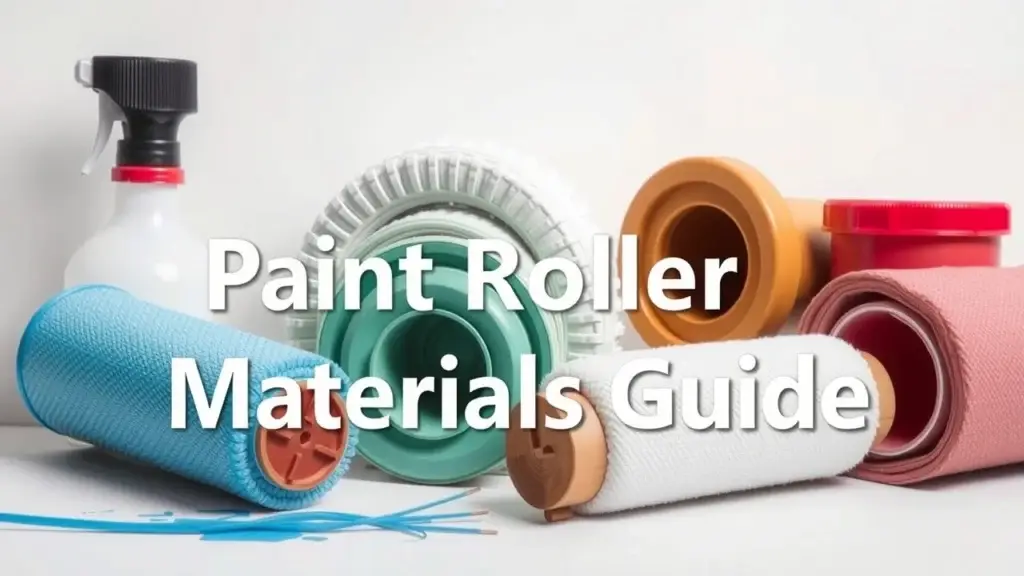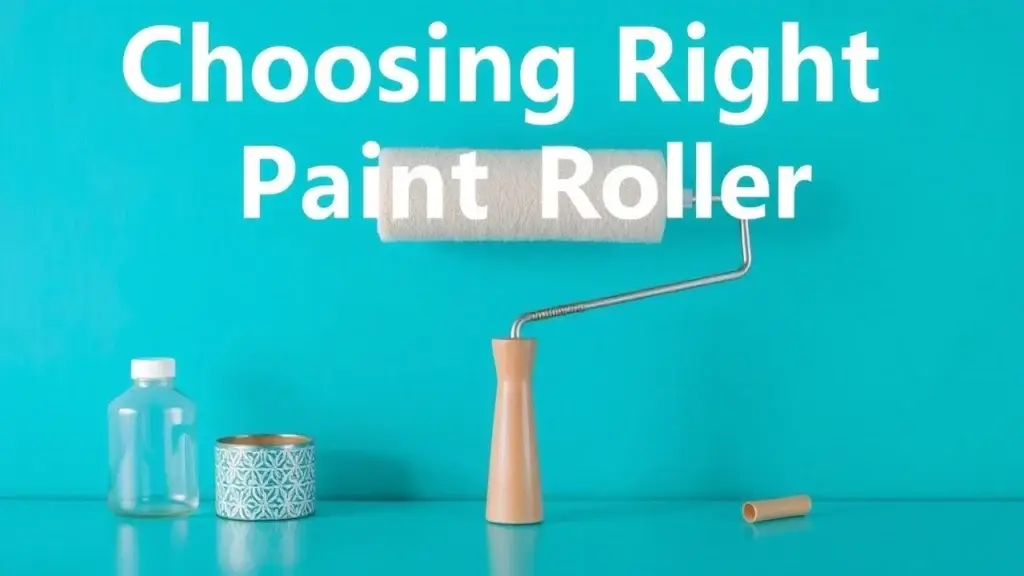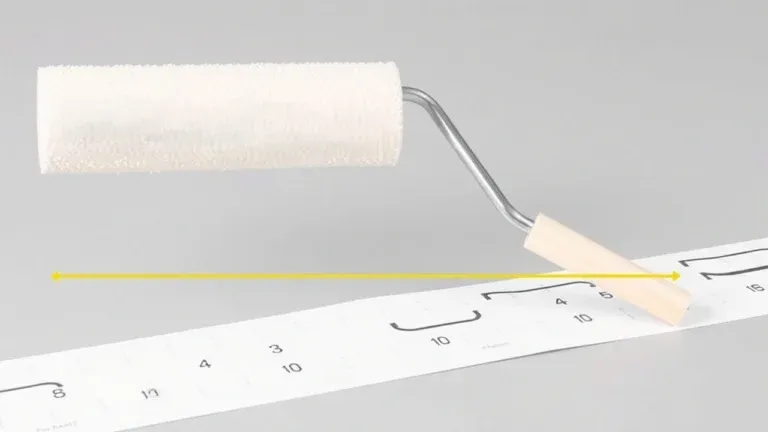Types of roller materials impact your paint job. Learn about nylon, polyester, and microfiber paint roller fabrics to choose the right one for your project.
What are Paint Rollers and Why Material Matters?

Paint rollers are handy tools for painting projects, whether you’re sprucing up your home or tackling an industrial job. They have a cylindrical core wrapped in a material that holds paint and spreads it smoothly on surfaces. The type of roller cover materials you pick can really change how good the finish looks.
There are different types of roller materials available, each made for specific tasks. Here are some common options:
- Nylon: This material is tough and resists wear, making it great for smooth surfaces.
- Polyester: A synthetic fiber that’s super absorbent and works well with both water-based and oil-based paints.
- Lambswool: Made from natural fibers, lambswool is soft and perfect for rough surfaces.
- Foam: These rollers are best for thin paints or stains but might struggle with thicker coatings.
Choosing the right paint roller material can make your job easier. It helps with better coverage, less splatter, and faster application. Picking the right type based on your project needs will lead to better results.
Key Material Properties Affecting Performance
When you’re looking at different roller cover materials, several important properties can impact how well they work:
- Absorbency: This tells you how much paint the material can soak up. High absorbency means fewer trips back to the paint tray during application.
- Durability: Some materials hold up better over time than others. Durable rollers keep their shape without shedding fibers.
- Shedding: If you use lower-quality rollers, they might shed lint onto your painted surface. Good-quality rollers minimize this issue.
- Texture: Different textures lead to different finishes—smoother covers give finer finishes, while textured ones can hide wall imperfections better.
- Cleanability: After you’re done painting, cleaning the rollers becomes key if you want to use them again. Some materials clean more easily than others based on what they’re made of.
Understanding these properties helps you choose from various types of roller materials that fit your painting needs perfectly—ensuring good performance every time you roll out fresh color!
Popular Paint Roller Fabric Types: A Detailed Comparison
Foam Rollers
Foam rollers are great for many painting jobs. They help create a smooth finish on flat surfaces. These rollers are light and easy to use, making them popular among DIY fans and pros. Plus, they are budget-friendly.
Best Uses
Foam rollers work best for applying primers or paints on smooth surfaces like drywall and plaster. They ensure even coverage and minimize brush marks.
Limitations
However, foam rollers have some downsides. They often wear out quickly and may shed fibers while painting. Also, they don’t work well on textured surfaces since they can’t hold enough paint.
Microfiber Rollers
Microfiber rollers are known for their great absorbency and durability. Their fine texture provides a very smooth finish, making them perfect for high-quality applications.
Best Uses
These rollers shine when used with top-tier paints on smooth interior walls. They perform exceptionally well with water-based paints.
Limitations
The main downside is that microfiber rollers can be pricier than foam ones, which might not appeal to everyone.
Polyester Rollers
Polyester rollers are versatile and tough. They can handle a variety of paints, including latex and oil-based options.
Best Uses
These rollers are suitable for both indoor and outdoor tasks across different surface types like wood or metal.
Limitations
Although polyester is effective, it might not absorb paint as well as microfiber. This could lead to uneven coverage if you’re not careful.
Nylon Rollers
Nylon rollers are super strong, making them ideal for thicker paints like oil-based ones or heavy-duty exterior finishes.
Best Uses
They work well on rough surfaces such as stucco or brick because they can handle the wear from uneven surfaces.
Limitations
However, nylon might struggle with paint absorption compared to softer materials like microfiber or lamb’s wool. This could cause uneven coverage if you’re not watching closely during application.
Mohair Rollers
Mohair rollers are soft and provide a luxurious finish while reducing linting issues often seen with cheaper options.
Best Uses
They are perfect for achieving professional results on delicate surfaces like furniture refinishing jobs where care is needed!
Limitations
The high quality comes at a higher price, plus you need to clean them carefully after use to keep them in good shape.
Lamb’s Wool Rollers
Lamb’s wool rollers have fantastic absorbency, leading to smoother finishes across various mediums, including stains and varnishes!
Best Uses
These are especially helpful for high-end finishing tasks where you need to be detail-oriented to avoid drips during application.
Limitations
Like mohair, lamb’s wool also tends to be expensive and requires special care after use to ensure it lasts long!
Choosing the Right Paint Roller Material Based on Your Project

Surface Type
Choosing a paint roller starts with knowing your surface type. For smooth surfaces like drywall or plaster, use a roller with a short nap, about 1/4 inch. This helps create an even finish without adding texture. On the flip side, if you’re painting textured surfaces such as stucco or brick, go for a roller with a longer nap, around 3/8 to 1 inch. These rollers can reach into crevices and ensure that you cover every part of the surface.
Here’s a quick tip: smoother surfaces need less paint because they absorb it less than textured ones.
Paint Type
The type of paint you’re using is also key to picking the right roller. If you have water-based paints, use synthetic rollers made from nylon or polyester. They resist water and hold their shape well during painting. If you are working with oil-based paints, consider natural fiber rollers like lambswool. These rollers soak up more paint and give a smoother finish.
For applying latex paints or acrylics, synthetic rollers are great due to their strength and easy cleaning after use. If you’re dealing with thick coatings like epoxy, high-density foam rollers work best as they are designed for heavier substances.
Desired Finish
Your finish matters too! If you want a smooth finish, fine-nap synthetic rollers help distribute paint evenly without creating texture. For those who prefer a more textured look, a medium-nap roller can give you just the right amount of pattern without losing quality.
If you’re going for high-gloss finishes, pay extra attention to your roller choice. Foam rollers are ideal here because they minimize bubbles and imperfections, resulting in an ultra-smooth look when applied properly.
Budget
Don’t forget about your budget! There are many options available, from cheap to high-quality paint rollers. While lower-cost options can save some cash upfront, investing in better materials usually gives better results over time because they last longer and work more effectively.
Finding the right balance between cost and quality will help you pick tools that meet your needs while sticking to your budget. This way, you’ll get excellent results without breaking the bank!
Paint Roller Nap Length: Understanding the Impact on Your Finish
When you want a smooth paint finish, knowing about roller nap length is super important. The nap length is just the thickness of the fibers on a paint roller cover. This measurement affects how much paint gets applied and what the surface will look like. Different projects need different finishes, so it’s key to pick the right nap length for what you’re working on.
What is Nap Length?
Nap length decides how much paint a roller can hold and spread. It also impacts how well the paint goes on and how it looks in the end. Short-nap rollers have less fiber height, making them great for smooth surfaces since they give an even coat with little texture. On the other hand, long-nap rollers have longer fibers that are perfect for rough or uneven surfaces. These longer fibers can reach into dips and bumps to apply more paint.
The choice between smooth roller covers and textured ones often depends on this important measurement—roller nap length can greatly influence whether you get a flat look or something with more depth.
Nap Length Guide for Different Surfaces
Choosing the best roller based on what you’re painting is really important. Here’s a handy guide to help you figure out which rollers work best for different surfaces:
Short Nap
Short-nap rollers are usually about 1/8 inch to 1/4 inch thick. They are perfect for smooth surfaces like drywall or plastered walls where you want little to no texture. Using short-nap rollers helps cut down on splatter while giving an even coat of paint.
Medium Nap
Medium nap rollers come in at about 3/8 inch to 1/2 inch thick. These are versatile and do well on semi-smooth surfaces like lightly textured walls or ceilings where you still want some absorption without losing too much detail in texture.
Long Nap
Long-nap rollers have pile heights of more than 1/2 inch, sometimes going up to about 1 inch thick or even more depending on design. They work best for rough textures like stucco or brickwork because their longer fibers can hold a lot of paint while covering all those bumps and irregular spots.
Understanding these differences helps you choose the right tools, leading to a better painting experience and giving you results that look professional, fitting your project needs just right.
Beyond the Fabric: Understanding Roller Frame and Handle Materials
Frame Materials: Metal vs. Plastic
When you choose roller frames, you mainly pick between metal and plastic. Each type has its ups and downs that affect how you paint.
Metal Frames: Metal frames are made from materials like steel or aluminum. They are strong and last a long time. These frames can handle heavy use, which is great for professional painters. But, metal frames are heavier. This extra weight might make your arms tired if you’re painting for a long time.
Plastic Frames: Plastic frames are light and easy to work with. They’re often the go-to choice for DIYers who don’t need the strength of metal for small home projects. While they are not as durable as metal and can crack if pushed too hard, they usually cost less.
In short, if you want something that will last through tough jobs, go with metal frames. If you need something lighter for occasional tasks around the house, plastic frames work just fine.
Handle Materials: Wood vs. Plastic
The material of paint roller handles is important too! It can change how comfortable they feel while you paint.
Wooden Handles: Wooden handles give a nice grip that feels good during long painting sessions. They have a natural texture that helps keep your hand steady. However, they can soak up moisture from paint over time, which might shorten their lifespan.
Plastic Handles: Plastic handles come in different qualities. Good ones are made with ergonomic designs that help reduce slipping. They often have rubber surfaces that give more grip and control while painting.
In the end, it really comes down to what feels best for you—wood offers comfort, while plastic provides more durability depending on the quality.
Choosing the Right Size
Picking the right size of paint roller matters based on what you’re working on—walls or ceilings? Here’s how to figure it out:
For large spaces like walls:
- 9-inch rollers cover a lot quickly.
For smaller jobs like touch-ups:
- 7-inch rollers let you work more precisely without making a mess around edges.
Knowing these size differences helps you finish your projects faster and more efficiently!
Additional Considerations
When selecting roller frame materials or handle designs, think about extra features that make your job easier! Look for ergonomic designs that ease hand strain and consider extendable poles to reach high areas without straining yourself too much! These small additions can really improve your overall painting experience, whether you’re a pro or just enjoying some DIY at home!
Best Practices for Roller Use and Maintenance

Using paint rollers right can really help you get the job done well. Knowing how to prepare, apply, clean, and maintain them will boost their performance and last longer.
Preparing Rollers Before Use
Before using paint rollers, proper preparation is key. Here are some tips:
- Choose the Right Material: Pick a roller cover that fits your project. Synthetic fibers work great for smooth finishes. Natural fibers are better for textures.
- Prime Your Roller: Soak your roller in water if you’re using water-based paint. For oil-based paints, use solvent instead.
- Loading Techniques: Dip the roller about one-third into the paint tray. Avoid overloading it to keep messes down.
When you start painting, keep steady pressure and speed for a nice finish.
Applying Paint with Rollers
To apply paint evenly, follow these steps:
- Start at a Corner: Begin in a corner of your wall and work in sections.
- Use a “W” Pattern: This helps spread the paint evenly without leaving lines or marks.
- Select Quality Supplies: Using a good tray can make a big difference.
A pro tip is to roll off extra paint on a dry surface first to avoid pooling.
Cleaning and Maintaining Paint Rollers
After using your rollers, clean them properly to extend their life. Here’s how:
- Latex Paint Cleanup: Rinse under warm running water until it’s clear. Reshape the nap before storing upright.
- Oil-Based Paint Cleanup: Use mineral spirits or turpentine for cleaning. Then rinse with soap and water.
For storage, keep cleaned rollers in a cool area out of direct sunlight.
Extending the Lifespan of Your Rollers
You can maximize the life of your rollers by following some best practices:
- Choose Durable Materials: Polyester covers last longer than cotton when used correctly.
- Consider Environment Factors: Use different rollers indoors versus outdoors. Outdoor conditions can cause quicker wear.
Investing in quality tools pays off over time compared to cheaper options that need replacing often.
By following these best practices for preparing, applying, cleaning, and maintaining your rollers, you’ll ensure they perform well and save money on replacements.
Frequently Asked Questions About Roller Materials
What are the different types of roller materials?
Roller materials include nylon, polyester, microfiber, foam, and lambswool. Each material has unique properties that affect performance.
How do I choose the right roller material for my project?
Consider the surface type and paint you will use. Different materials work better on smooth versus rough surfaces and with various paint types.
Which roller material is best for oil-based paints?
Nylon and lambswool rollers are great for oil-based paints. They absorb well and provide a smooth finish.
Are there rollers designed for high-temperature applications?
Yes, there are temperature-resistant rollers. These can handle high heat without degrading.
What is the lifespan of paint rollers?
The lifespan varies based on material and care. High-quality rollers last longer than budget options if maintained properly.
Additional Insights on Roller Material Selection
- Types of Paint Roller Fabrics: Common fabrics include polyurethane, sheepskin, microfiber, and synthetic fibers.
- Specialty Rollers: Consider mini paint rollers for tight spaces or pad rollers for precise applications.
- Roller Pile Height: Choose short nap for smooth surfaces and long nap for rough textures.
- Chemical Resistance: Some rollers resist solvents and chemicals, making them suitable for specific tasks.
- Buying Guide: Look at brands like Wooster or Purdy when selecting high-quality rollers.
- Paint Application Techniques: Use even strokes to minimize drips and achieve a smooth finish.
- Maintenance Tips: Clean your rollers after each use to prolong their life. Store them in a cool place away from direct sunlight.
- Cost Factors: Budget-friendly options exist, but investing in durable products pays off over time.
- Roller Frame Options: Metal frames offer durability while plastic frames are lighter and easier to handle.
Using these insights can help you select the best roller materials for your painting projects.
Related Topics
- Types of paint rollers
- Types of roller covers
- Types of paint roller frames
- Types of paint roller handles
- Types of paint roller naps
- Types of paint roller finishes
- Types of paint for rollers
- Types of surfaces for paint rollers
- Types of paint roller brands



Types of Roller Materials: A Guide for Painters